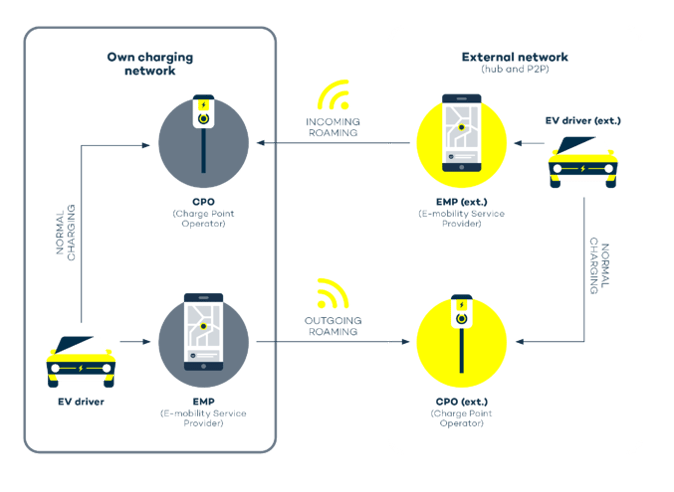Why roaming is the buzzword in electric vehicle charging
We’re all familiar with the term ’roaming’. When you travel to another country and switch your mobile phone back on after landing, it automatically connects to a local network. Roaming in electric vehicle (EV) charging is similar to this.
What is EV roaming?
When Charging Point Operators (CPO) and E-Mobility Service Providers (EMSP) unite, they create a roaming network which provides EV drivers with an optimal user experience. Essentially, EV roaming allows EV drivers to charge their cars outside their charging service provider’s network with only one customer account.
As the global sales of electric vehicles keep growing, EV roaming is here to ensure that service providers can keep up with the ongoing EV boom.

The three layers of EV roaming
Roaming networks consist of multiple layers. The first layer includes the charging network of a specific service provider. Outside that network lies the second layer, usually a more extensive local or public charging network – such as the Virta network.
In practice, this means that an EV driver registered to one of Virta’s customer’s services has access to all the charging stations of our B2B customers and vice versa. This internal charging station network is available to EV drivers with one contract or registration.
The third layer consists of hub and peer-to-peer roaming agreements made with other charging networks. The EV charging world can be full of new terms and abbreviations, so let’s look at ‘hub’ and ‘peer-to-peer’ roaming a bit closer.

Roaming hubs - centralised networks open to all
Roaming hubs, such as Hubject or Gireve, enable their members to access various e-mobility partners. These hubs create one centralised roaming network open to all its members.
Peer-to-peer roaming – popular but not ideal
Peer-to-peer roaming includes bilateral agreements between two service providers. This type of roaming enables two prominent market players to consolidate their market position and pursue more profits.
However, peer-to-peer roaming is not an optimal solution from the EV driver’s point of view. Consumers must stay up to date on the structure of the EV market to see who makes a contract with whom. That’s not very convenient, right? Additionally, bilateral roaming is more costly to operate.
The technology behind peer-to-peer roaming is called Open Charge Point Interface (OCPI), a protocol that enables a connection between CPOs and EMSPs. This protocol was defined by the EVRoaming Foundation and is being constantly developed.
To fully achieve a customer-centric service model, we need centralised EV roaming structures, reasonable and fair to all included players.
The truth is that the EV roaming market is not yet very mature. The protocols and standards for interoperability covering the EU countries are lacking. But many things are under work, mainly from a pricing and contractual regulations perspective.
What’s important is to ensure technology neutrality. Several technologies are already on the market, and new ones are being developed continuously. Technologies shouldn’t be regulated if we want to make room for constant development.
Everyone benefits from EV roaming
Functioning and reliable EV roaming is necessary for the mass adoption of electric vehicles. Roaming networks open up access to thousands of charging stations globally. With broad EV charging options, EV drivers can forget about range anxiety, which still, to this day, is a common worry holding consumers back from purchasing an EV. Roaming offers EV drivers a consistent and hassle-free charging experience no matter where they drive.
The benefits of EV roaming go further than the convenience for EV drivers. For CPOs, EV roaming presents an increased utilisation of their existing charging points, the potential to attract new customers and an opportunity to open a new revenue stream.
EMSPs can, thanks to EV roaming, open the world up to their customers by allowing them to charge anywhere. These customers won’t have to switch operators when travelling out of their own charging network, which means stronger brand loyalty to their EMSP. It’s clear that everyone benefits from EV roaming in some way.
Roaming with Virta
An end-to-end roaming solution is included in Virta’s standard charging solution. As a Virta customer, there is no need for you to have your own resources to handle all the roaming business. All the processes are automated and handled on your behalf, from developing the roaming networks and managing roaming contracts to processing transactions and handling VAT.
Roaming can bring you 10x more potential EV drivers who can charge at your charging stations. Since Virta is part of Hubject and Gireve, two major roaming platforms, millions of EV drivers get access to your charging stations. In some cases, the utilization rate of your charger can be improved by up to 600%.
And vice versa, with roaming, your customers can access over 250 000 charging stations globally. Roaming holds enormous value, both for you and your customers. At Virta, we can help you discover that value for yourself.
New content alerts
You may also like
These related stories
/ev-charging-mobile-app-user-interface.webp?width=1920&height=1080&name=ev-charging-mobile-app-user-interface.webp)
EMSP and CPO: the two sides of EV charging network operators
/urban-electric-car-charging-smartphone-interaction.webp?width=1920&height=1080&name=urban-electric-car-charging-smartphone-interaction.webp)
EV charging business – Hidden costs and how to avoid them
/electric-car-mountain-road-trip.webp?width=1920&height=1080&name=electric-car-mountain-road-trip.webp)
EV road trip in Switzerland w/ Joonas Linkola & Mercedes Benz EQC
/businessman-charging-blue-electric-vehicle-beside-urban-building.webp?width=1920&height=1080&name=businessman-charging-blue-electric-vehicle-beside-urban-building.webp)
